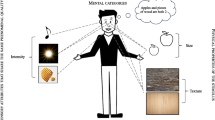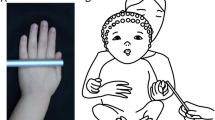Abstract
By 2–3 months, infants engage in exploration of their own body as it moves and acts in the environment. They babble and touch their own body, attracted and actively involved in investigating the rich intermodal redundancies, temporal contingencies, and spatial congruence of self-perception. Recent research is presented, which investigats the spatial and temporal determinants of self-perception and action infancy. This research shows that, in the course of the first weeks of life, infants develop an ability to detect intermodal invariants and regularities in their sensorimotor experience, which specify themselves as separate entities agent in the environment. Recent observations on the detection of intermodal invariants regarding self-produced leg movements and auditory feedback of sucking by young infants are reported. These observations demonstrate that, early in development and long before mirror self-recognition, infants develop a perceptual ability to specify themselves. It is tentatively proposed that young infants’ propensity to engage in self-perception and systematic exploration of the perceptual consequences of their own action plays an important role in the intermodal calibration of the body and is probably at the origin of an early sense of self: the ecological self.
Similar content being viewed by others
Author information
Authors and Affiliations
Rights and permissions
About this article
Cite this article
Rochat, P. Self-perception and action in infancy. Exp Brain Res 123, 102–109 (1998). https://doi.org/10.1007/s002210050550
Issue Date:
DOI: https://doi.org/10.1007/s002210050550




